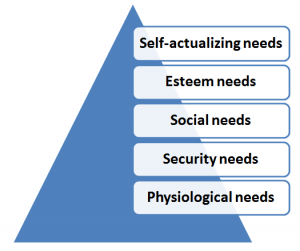We all have needs. When we’re stuck, dealing with unmet needs can help get things moving forward again. Understanding needs can be like peeling an onion; there are many layers. It may be a bit painful in the peeling, yet good things can happen afterwards, not the least of which is crafting sustainable solutions, as opposed to just short-term fixes to problems.
Ok, all that’s good. Lately, however, I’ve been thinking there might be better ways to represent the relationship between needs than the oft-used Maslow hierarchy.
Maslow’s hierarchy of needs
 This is probably old hat to most of you, yet here’s a quick review:
This is probably old hat to most of you, yet here’s a quick review:
In the 1940s, Abraham Maslow developed a hierarchy of needs, as a way of explaining human motivation. It remains a useful way of thinking about why people say and do certain things, and can be applied everywhere (e.g., Hierarchy of Customer Service, a Wikinomics post or hierarchy of self-discipline, as referenced in this post by popular blogger Penelope Trunk). At the bottom rung of the hierarchy, typically shown as a pyramid, are needs such as food, sex, and sleep. Level 2 is security; of body, employment, property, family. Higher needs include the need to be loved, recognized, and the need to realize our full potential (self-actualization), which includes the need for creativity and problem solving.
The hierarchy suggests a relationship between needs, with basic needs the foundation on which other needs are built. If someone is going hungry, or suffering in an abusive relationship, how focused or committed are they to conversations about achievement and creativity at work?
Some musings
 As an interest-based mediator (e.g., as taught by the Justice Institute of BC’s Centre for Conflict Resolution), I think about peeling the onion, a lot. And, while the importance of satisfying foundational needs seems intuitive:
As an interest-based mediator (e.g., as taught by the Justice Institute of BC’s Centre for Conflict Resolution), I think about peeling the onion, a lot. And, while the importance of satisfying foundational needs seems intuitive:
- In reality, the division between need levels is blurred
- The relationship and interdependencies between needs (at any and all levels) can be a dog’s breakfast think, monkey mind
- Representation of the needs as a hierarchy seems so linear in lieu of today’s increasingly systems-oriented world (just looking at the ‘needs’ Wordle diagram I created here, makes me think differently)
- What is the relative importance of needs e.g., could one create an individualized map, reflecting their own unique need ratios?
- How do these need ratios vary by types of individuals, types of professions
So I ask you, what other visual ways can we represent the relationship between needs, that will aid us in peeling the onion?
If you enjoyed this post, please consider leaving a comment or subscribing to my blog. Thanks, Ben.

Wow, I haven’t thought about Maslow’s hierarchy in years. I agree — a modern interpretation of a person’s needs would be better represented by a more fluid illustration. I’m particularly drawn to the idea you pose at the end of article: do need ratios vary by types of individuals, types of professions? Absolutely!
This is only the second post I’ve read on your site, and already I’m hooked. A pleasure to read!
Joanne… Sorry for delay in getting back to you. Thanks for your feedback, and let me know if you come up with another visual for interpreting needs! I’ll share it here.